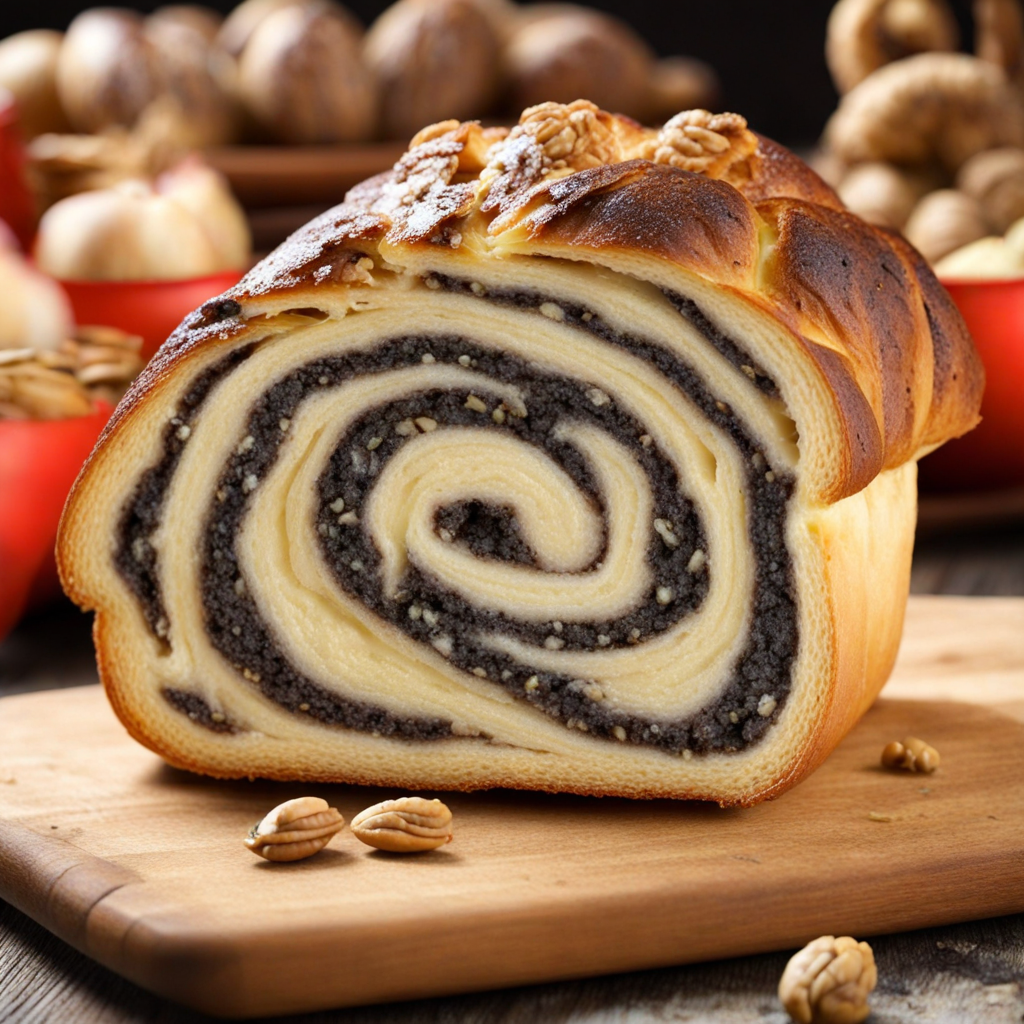Romanian Apple Cake
Romanian Apple Cake, known as "Prăjitură cu Mere" in Romanian, is a delightful dessert that beautifully combines the natural sweetness of apples with a tender, moist cake. The cake is typically made with a simple batter of flour, sugar, eggs, and oil, which creates a light and fluffy texture. Freshly grated apples are the star of the show, infusing the cake with a warm, fruity flavor that perfectly balances sweetness and tartness. Often enhanced with a touch of cinnamon, this cake boasts a comforting aroma that fills the kitchen as it bakes, inviting everyone to indulge in a slice. As you take your first bite, the cake's slight crunch from the baked apples contrasts harmoniously with the soft crumb of the cake. The apples not only provide moisture but also a delightful burst of flavor, making each mouthful a satisfying experience. Some variations of Romanian Apple Cake incorporate nuts, such as walnuts or hazelnuts, adding an extra layer of texture and richness. A dusting of powdered sugar on top gives it a charming finish, making it not only delicious but visually appealing as well. Romanian Apple Cake is often enjoyed as a cozy dessert during family gatherings or festive occasions, but it can also serve as a comforting snack with a cup of coffee or tea. Its simplicity and heartwarming flavors make it a cherished recipe passed down through generations, embodying the essence of homemade goodness. Whether served warm or at room temperature, this cake is a delightful way to explore the flavors of Romania and discover the joy of traditional baking.
How It Became This Dish
The History of Tort de Mere: A Romanian Culinary Treasure Origins Tort de mere, or apple cake, is a cherished dessert in Romania, particularly known for its comfort and nostalgia. The name itself translates to “mother’s cake,” which immediately evokes a sense of warmth and homeliness. The origins of tort de mere can be traced back to the rural traditions of Romanian households, where apples were abundant and often harvested from home gardens or local orchards. In Romania, apples have been cultivated for centuries, with various native varieties thriving in the country's temperate climate. The fruit's versatility made it a staple in many households, not just as a fresh snack but also as an ingredient in numerous traditional dishes. The use of apples in desserts can be found across many cultures, but in Romania, it took on a unique identity, reflecting local ingredients, culinary styles, and cultural practices. Cultural Significance Tort de mere is more than just a dessert; it is a symbol of familial bonds and the nurturing spirit of motherhood. Traditionally, this cake is associated with home cooking, often made for family gatherings, celebrations, and even during the harvest season when apples are at their peak. Mothers and grandmothers have passed down recipes through generations, each adding their own personal touches, creating a tapestry of variations across the country. In Romanian culture, the act of baking is an expression of love and care. Tort de mere embodies this sentiment, often being served during significant life events such as birthdays, weddings, and holidays, particularly during the autumn months when apples are in season. The cake is often accompanied by a cup of tea or coffee, making it a delightful treat for guests and family alike. In rural communities, the preparation of tort de mere often involves gathering family members, creating a communal atmosphere filled with laughter and stories. This not only strengthens family bonds but also reinforces cultural traditions, highlighting the importance of shared meals in Romanian society. The cake serves as a reminder of the past, evoking memories of childhood and the warmth of home. Development Over Time The evolution of tort de mere reflects broader trends in Romanian culinary practices and influences from neighboring regions. Historically, Romanian cuisine has been shaped by the interactions with various cultures, including Ottoman, Austro-Hungarian, and Slavic influences. Each of these interactions brought new ingredients and techniques that enriched traditional recipes. The basic recipe of tort de mere has remained relatively simple, focusing on the natural sweetness of apples, combined with basic pantry staples like flour, sugar, eggs, and butter. However, over time, variations began to emerge, influenced by regional preferences and available ingredients. In some areas, nuts, such as walnuts or hazelnuts, are added for texture and depth. Spices like cinnamon, nutmeg, or vanilla have been incorporated to enhance the flavor profile, reflecting the warm and aromatic qualities often associated with autumn. As Romania underwent social and economic changes, particularly in the 20th century, the availability of ingredients and kitchen technology began to shift. The introduction of modern appliances made baking more accessible, leading to an increase in the popularity of tort de mere in urban areas. This shift also contributed to the commercialization of the dish, with local bakeries and patisseries offering their own versions, each with unique interpretations of the classic recipe. In contemporary Romania, tort de mere has seen a renaissance, with many chefs and home bakers embracing traditional recipes while experimenting with new techniques and presentations. The cake is now often featured in culinary festivals and competitions, showcasing the pride and skill of Romanian bakers. Social media has played a significant role in this revival, allowing home cooks to share their variations and inspiring others to explore the rich heritage of Romanian desserts. Modern Interpretations Today, tort de mere is enjoyed not only in Romania but also among the Romanian diaspora around the world. The cake serves as a culinary ambassador, connecting Romanians abroad with their roots and traditions. Modern interpretations of tort de mere may include gluten-free or vegan variations, catering to contemporary dietary preferences while honoring the essence of the original recipe. Additionally, the cake is often paired with modern twists, such as serving it alongside ice cream, drizzling it with caramel sauce, or incorporating seasonal fruits. The adaptability of tort de mere demonstrates its enduring appeal, showing that while the core ingredients remain constant, the ways in which it can be enjoyed are limitless. Conclusion Tort de mere stands as a testament to the rich culinary heritage of Romania. It is a dish steeped in history, cultural significance, and the warmth of family traditions. From its humble beginnings in rural kitchens to its status as a beloved dessert enjoyed by generations, tort de mere encapsulates the essence of Romanian hospitality and the enduring power of food to connect us with our past. As we continue to celebrate this delightful apple cake, it remains a delicious reminder of the stories, traditions, and flavors that shape our identities. Whether enjoyed in a rustic farmhouse or a modern café, tort de mere invites everyone to partake in the sweet nostalgia of home, where every bite tells a story of love, care, and the simple joys of life.
You may like
Discover local flavors from Romania







